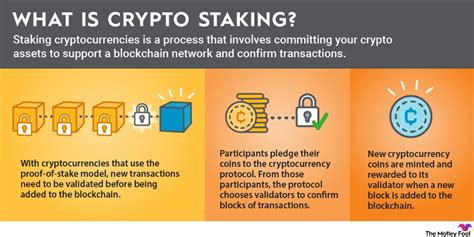
So, you’re curious about staking in the world of crypto? You’ve come to the right place! Think of staking as a way to earn some passive income from your digital currencies. By locking up your coins in a network, you help keep the system running smoothly and, in return, you get rewarded—kinda like interest at a bank, but often with way more exciting possibilities! Let’s dive into this cool concept and explore how it all works.
Understanding Staking in Crypto
Staking in cryptocurrency is like a VIP membership at an exclusive club. Just as members of a club may invest in its amenities or enjoy its perks, crypto enthusiasts can invest their coins to unlock rewards on various blockchain networks. This process typically involves holding a certain amount of cryptocurrency in a digital wallet to support the operations of a network, such as validating transactions or maintaining security. While this concept might sound complex at first, it’s relatively straightforward once you grasp the fundamentals. Essentially, when you stake your assets, you’re locking them up for a set period of time, which helps ensure the network’s integrity without requiring excessively high computing power, as is the case with traditional mining.
How Does Staking Work?
The mechanics of staking can vary significantly between different cryptocurrencies and their respective networks. Generally, when you stake your coins, you are effectively participating in the network’s consensus mechanism—commonly one called Proof of Stake (PoS). In PoS systems, validators are chosen based on the number of coins they hold and are willing to “stake” as collateral. This means that the more coins you stake, the higher your chances of being selected to validate transactions and earn rewards. It’s somewhat like putting your name in a hat, where each dollar you invest gives you an additional entry. When a transaction is confirmed, validators earn cryptocurrency as a reward. This incentivizes individuals not only to stake their coins but also to act honestly since any malicious behavior could result in losing their staked coins. While the exact details can differ between networks, the primary goal remains the same: to secure the network while rewarding participants for their contributions.
The Benefits of Staking
Staking offers several benefits that can be quite appealing to cryptocurrency enthusiasts. First and foremost, it provides a passive income stream. By simply locking away your coins for a while, you can earn additional tokens without needing to engage in the fast-paced trading often associated with crypto. This is especially attractive for those who prefer a more hands-off approach and aren’t keen on daily market fluctuations. Besides passive income, staking can also bolster the security and functionality of the blockchain network. A larger number of stakers can lead to a more decentralized network, which is fundamental for the credibility and longevity of cryptocurrencies. Moreover, many networks offer additional perks for stakers, such as voting rights on governance proposals or access to exclusive community events, thus enhancing the overall experience within the ecosystem. This combination of benefits makes staking not just about financial gain, but also about being a part of something larger.
Risks Involved in Staking
Like any financial endeavor, staking comes with its fair share of risks, and it’s crucial for potential stakers to be well-informed before diving in. One of the primary concerns is the potential for price volatility. Cryptocurrency markets can swing dramatically in short periods; thus, while you may be earning interest from staking, the value of your staked coins could plummet, negating any gains. Additionally, some networks impose lock-up periods during which you cannot access your assets. If you’re facing a sudden market downturn, having your coins off-limits could be particularly distressing. Furthermore, there’s also the risk of losing your staked assets due to network attacks or mismanagement. If the network undergoes drastic changes or if the staking mechanism isn’t well-architected, your funds could be in jeopardy. Therefore, being aware of these risks and doing thorough research on the network and its developers is key before committing your hard-earned coins.
Getting Started with Staking
If you’ve decided that staking sounds like an interesting opportunity, you may be wondering how to get started. The first step is to select a cryptocurrency that allows staking. Popular options include Ethereum, Cardano, and Tezos, among others. Each comes with its unique requirements, rewards, and mechanisms. Once you’ve chosen a crypto, you’ll need a compatible wallet to store your coins. Many exchanges also offer staking services directly, which can make the process easier, especially for newcomers. After you’ve figured all that out, the next step is to actually start staking! You typically need to lock up a minimum amount of coins for a set period of time, and then you can sit back and watch as your staked coins earn you rewards. It’s also worth keeping up with the announcements from the crypto’s developers, as staking parameters can change and new opportunities may arise. Lastly, don’t forget to strategize—such as considering whether you’ll reinvest your earnings to compound your rewards or cash out periodically for personal expenses.
Understanding Staking in Cryptocurrency
Staking is a term often thrown around in the crypto world, but what does it really mean? At its core, staking is the process of participating in block validation (similar to mining) on a proof-of-stake (PoS) blockchain. In simpler terms, when you stake your coins, you’re locking them up to support the operations of a blockchain network. In return, you get rewarded with more cryptocurrency! It’s a win-win situation for both you and the blockchain. So, let’s break it down further.
1. How Does Staking Work?
Staking works by allowing users to lock their coins in a wallet to support the blockchain network’s functioning. In proof-of-stake systems, validators are chosen to create new blocks and confirm transactions based on the number of coins they hold and are willing to ‘stake’. This contrasts with traditional proof-of-work (PoW) modes where miners solve complex mathematical problems to validate transactions. On a PoS blockchain, the likelihood of being selected as a validator increases with the amount of cryptocurrency being staked.
| Staking Mechanism | Description |
|---|---|
| Proof of Stake (PoS) | Validators are chosen based on the number of coins staked. Less energy-intensive compared to PoW. |
| Delegated Proof of Stake (DPoS) | Coin holders vote for delegates who validate transactions on their behalf, creating a more democratic process. |
By contributing your coins to this process, you can help maintain the integrity and security of the blockchain while earning passive income in crypto. This is one of the alluring aspects of staking—it not only helps maintain the network but can also be a sustainable source of income for participants.
2. The Benefits of Staking
Staking comes with numerous advantages. First and foremost, it allows for the earning of rewards. Depending on the specific cryptocurrency and network, staking rewards can vary significantly—ranging from 5% to over 20% annually! These rewards often accumulate quickly, especially when compounded. In addition to potential returns, staking can also contribute to the overall health of the network. Higher staking participation can improve the security and decentralization of the blockchain.
Another perk of staking is its generally low entry barrier. Unlike mining, which often requires expensive equipment and an extensive understanding of the technology, staking typically just requires a wallet and some cryptocurrency. You can begin staking with relatively small amounts, making it accessible for the average individual. Moreover, as a staker, you still retain ownership of your coins. Unlike sending them off to a mining pool or exchange, staking simply means you’re temporarily locking them up. Once you choose to unstake, the coins are back in your control.
3. Risks Involved in Staking
As with any investment, staking comes with its own set of risks. First, the cryptocurrency market is highly volatile. The value of the coins you’re staking can fluctuate greatly. If the market crashes, even if you’re earning staking rewards, the overall value of your staked assets could decrease significantly. Another factor to consider is the potential for technical issues. If you’re staking through your own wallet, there’s the chance of losing your coins due to hardware malfunctions, software bugs, or accidents like deleting your wallet file.
Moreover, many staking projects come with lock-up periods, meaning you cannot access your funds for a certain time. This can lead to a situation where you miss out on short-term opportunities just because your funds are stuck. Lastly, regulatory changes can pose challenges, as governments worldwide are still developing clear guidelines around cryptocurrencies and staking. It’s wise to stay informed and ensure that you’re staking only with reputable projects to minimize risks.
4. Popular Cryptocurrencies for Staking
There are several popular cryptocurrencies that offer staking opportunities, each with its unique features and community support. Some of the most common options include:
| Cryptocurrency | Annual Returns | Minimum Staking Amount |
|---|---|---|
| Ethereum | 5% – 20% | 32 ETH |
| Cardano | 4% – 6% | 10 ADA |
| Polkadot | 10% – 12% | 1 DOT |
| Tezos | 5% – 7% | 1 XTZ |
These staking options provide users with diverse opportunities to earn rewards while supporting their networks. Each has varying annual returns and minimum staking amounts, catering to a wide range of investors.
5. FAQs About Staking in Cryptocurrency
Q1: What is the difference between staking and mining?
A1: Staking involves locking up coins to support network operations and earn rewards, while mining typically requires solving complex computations to validate transactions on proof-of-work networks.
Q2: Can anyone stake cryptocurrency?
A2: Yes, anyone with the required cryptocurrency can participate in staking. It usually just requires a compatible wallet and some understanding of the staking process.
Q3: Is staking safe?
A3: While staking can be safe, it comes with risks such as the potential loss of assets, volatility, and technical issues. It’s crucial to use reputable platforms or wallets.
Q4: What happens if I unstake my coins?
A4: Unstaking your coins often means you stop earning rewards. Depending on the blockchain, there may also be a waiting period before you can access your funds.
Q5: Do I need special equipment to stake?
A5: No special equipment is needed to stake. Most of the time, you can stake using regular hardware or even on exchanges that offer staking services.
Q6: How are staking rewards calculated?
A6: Staking rewards are generally calculated based on the number of coins staked and the duration they remain locked up, which is then translated into an annual percentage yield.
Q7: Can I lose my staked coins?
A7: Yes, it is possible to lose staked coins primarily due to market volatility, penalties incurred through slashing (in the case of validator misconduct), or technical failures.
Q8: Are staking rewards taxable?
A8: In many jurisdictions, staking rewards can be subject to taxes. It’s essential to consult with a tax professional in your area to understand the specific obligations.
Q9: How long is the staking period?
A9: The staking period can vary based on the cryptocurrency and the platform. Some may allow staking for a specific duration, while others permit withdrawal at any time.
Q10: Can I stake on multiple coins?
A10: Yes, many investors choose to stake multiple cryptocurrencies to diversify their portfolios and maximize potential rewards.
Q11: What is slashing in staking?
A11: Slashing refers to the process of penalizing a staker by reducing their staked amount or rewards due to network rule violations or downtime of a validating node.
Q12: How do I start staking?
A12: To start staking, choose a cryptocurrency that supports staking, acquire the coins, and either transfer them to a staking wallet or a staking platform that offers the service.
Q13: What is a staking pool?
A13: A staking pool combines resources from multiple stakers to increase the chances of being selected as a validator, allowing more efficient earning of rewards.
Q14: Is staking better than simply holding?
A14: Staking can potentially provide higher returns than holding, as you earn rewards on your investment. However, holding means you retain liquidity and control over your assets.
Q15: What should I consider before staking?
A15: Before staking, consider the cryptocurrency’s volatility, the reputation of the platform, potential lock-up periods, and your own financial goals.
Wrapping It Up
Thanks for sticking around and diving into the world of staking in crypto with us! It’s a fascinating way to earn some passive income while supporting the networks you love. Remember, just like with any investment, it’s always a good idea to do your research and stay informed. We hope you found this article helpful and engaging. Don’t forget to swing by again for more crypto insights and tips! Happy staking!











